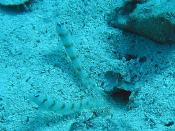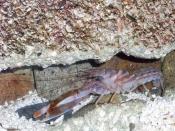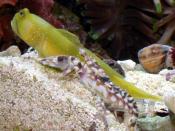As a watchman goby fish peeks his head out of a hole on the sea floor, a pair of antennas arise from aside him, followed by a flurry of rocks and sand being moved by a pistol shrimp. At first, one might think that this odd couple should be fighting each other for ownership of the hole but in reality, they both greatly benefit from sharing the same hole in the ground.
If the pistol shrimp lived alone, it would be more vulnerable to predators due to its very poor eyesight. If the watchman goby fish lived on its own, it would not have a hole to begin with, due to the fact that it has no extremities besides its fins to dig with. But if they lived together, then the goby could "stand guard" while the pistol shrimp makes and maintains their burrow. The pistol shrimp uses its long antennas to communicate with the goby, so if the goby suddenly darts in to the burrow because it saw a predator, the pistol shrimp would quickly follow.
This close partnership that the goby and the shrimp have is called symbiosis. Symbiosis is a close ecological relationship between two (or more) different species in which each one benefits from one another (John R. Meyer).
The watchman goby and pistol shrimp are not the only examples of symbiosis, symbiosis exists in a wide variety of species, even humans have symbiotic relations with different animals.
Scholars have tried explaining symbiosis, and have theorized that it evolved out of parasitism (organisms living of other organism at their expense) (John W. Kimball ).
Symbiosis is a very vital aspect of life on earth. Without it, plants would not be able to pollinate, animals would have a much harder time digesting food and,


